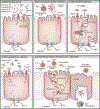Oral iron therapy: Current concepts and future prospects for improving efficacy and outcomes
- PMID: 38253961
- PMCID: PMC10939879
- DOI: 10.1111/bjh.19268
Oral iron therapy: Current concepts and future prospects for improving efficacy and outcomes
Abstract
Iron deficiency (ID) and iron-deficiency anaemia (IDA) are global public health concerns, most commonly afflicting children, pregnant women and women of childbearing age. Pathological outcomes of ID include delayed cognitive development in children, adverse pregnancy outcomes and decreased work capacity in adults. IDA is usually treated by oral iron supplementation, typically using iron salts (e.g. FeSO4 ); however, dosing at several-fold above the RDA may be required due to less efficient absorption. Excess enteral iron causes adverse gastrointestinal side effects, thus reducing compliance, and negatively impacts the gut microbiome. Recent research has sought to identify new iron formulations with better absorption so that lower effective dosing can be utilized. This article outlines emerging research on oral iron supplementation and focuses on molecular mechanisms by which different supplemental forms of iron are transported across the intestinal epithelium and whether these transport pathways are subject to regulation by the iron-regulatory hormone hepcidin.
Keywords: DMT1; FPN; anaemia; hepcidin; intestinal iron absorption; iron supplementation.
© 2024 British Society for Haematology and John Wiley & Sons Ltd.
Figures

References
-
- CDC. Micronutrient Facts | Nutrition | CDC: @CDCgov; 2022. [updated 2022-02-01T06:31:52Z. Available from: https://www.cdc.gov/nutrition/micronutrient-malnutrition/micronutrients/....
-
- Zimmermann MB, Hurrell RF. Nutritional iron deficiency. The Lancet 2007;370(9586):511–20. - PubMed
-
- Camaschella C Iron deficiency. Blood 2019;133(1):30–9. - PubMed
-
- Pasricha S-R, Tye-Din J, Muckenthaler MU, Swinkels DW. Iron deficiency. The Lancet 2021;397(10270):233–48. - PubMed
-
- Camaschella C Iron deficiency: new insights into diagnosis and treatment. Hematology 2015;2015(1):8–13. - PubMed
Publication types
MeSH terms
Substances
Grants and funding
LinkOut - more resources
Full Text Sources

